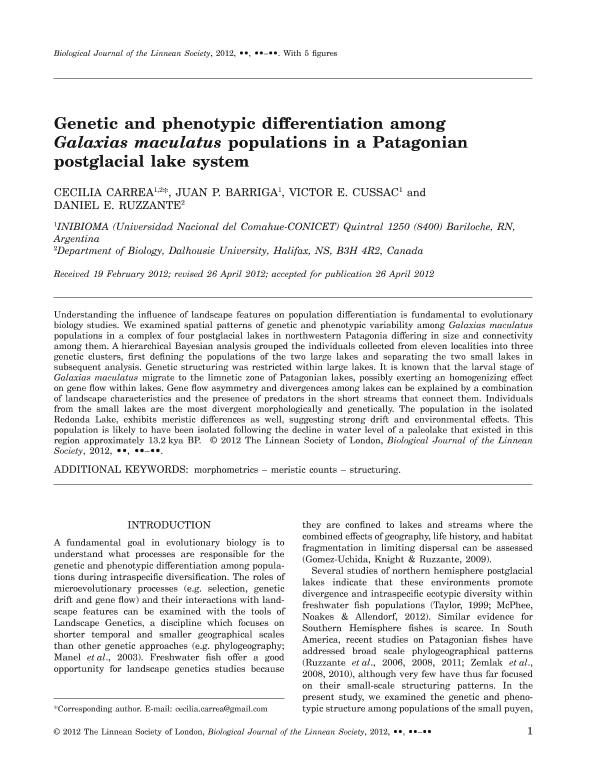Mostrar el registro sencillo del ítem
dc.contributor.author
Carrea, Cecilia

dc.contributor.author
Barriga, Juan Pablo

dc.contributor.author
Cussac, Victor Enrique

dc.contributor.author
Ruzzante, Daniel E.

dc.date.available
2019-03-18T18:30:59Z
dc.date.issued
2012-10
dc.identifier.citation
Carrea, Cecilia; Barriga, Juan Pablo; Cussac, Victor Enrique; Ruzzante, Daniel E.; Genetic and phenotypic differentiation among Galaxias maculatus populations in a Patagonian postglacial lake system; Wiley Blackwell Publishing, Inc; Biological Journal of The Linnean Society; 107; 2; 10-2012; 368-382
dc.identifier.issn
0024-4066
dc.identifier.uri
http://hdl.handle.net/11336/71887
dc.description.abstract
Understanding the influence of landscape features on population differentiation is fundamental to evolutionary biology studies. We examined spatial patterns of genetic and phenotypic variability among Galaxias maculatus populations in a complex of four postglacial lakes in northwestern Patagonia differing in size and connectivity among them. A hierarchical Bayesian analysis grouped the individuals collected from eleven localities into three genetic clusters, first defining the populations of the two large lakes and separating the two small lakes in subsequent analysis. Genetic structuring was restricted within large lakes. It is known that the larval stage of Galaxias maculatus migrate to the limnetic zone of Patagonian lakes, possibly exerting an homogenizing effect on gene flow within lakes. Gene flow asymmetry and divergences among lakes can be explained by a combination of landscape characteristics and the presence of predators in the short streams that connect them. Individuals from the small lakes are the most divergent morphologically and genetically. The population in the isolated Redonda Lake, exhibits meristic differences as well, suggesting strong drift and environmental effects. This population is likely to have been isolated following the decline in water level of a paleolake that existed in this region approximately 13.2kya BP. © 2012 The Linnean Society of London.
dc.format
application/pdf
dc.language.iso
eng
dc.publisher
Wiley Blackwell Publishing, Inc

dc.rights
info:eu-repo/semantics/openAccess
dc.rights.uri
https://creativecommons.org/licenses/by-nc-sa/2.5/ar/
dc.subject
Meristic Counts
dc.subject
Morphometrics
dc.subject
Structuring
dc.subject.classification
Otras Ciencias Biológicas

dc.subject.classification
Ciencias Biológicas

dc.subject.classification
CIENCIAS NATURALES Y EXACTAS

dc.title
Genetic and phenotypic differentiation among Galaxias maculatus populations in a Patagonian postglacial lake system
dc.type
info:eu-repo/semantics/article
dc.type
info:ar-repo/semantics/artículo
dc.type
info:eu-repo/semantics/publishedVersion
dc.date.updated
2019-03-08T16:45:32Z
dc.journal.volume
107
dc.journal.number
2
dc.journal.pagination
368-382
dc.journal.pais
Reino Unido

dc.journal.ciudad
Londres
dc.description.fil
Fil: Carrea, Cecilia. Consejo Nacional de Investigaciones Científicas y Técnicas. Centro Científico Tecnológico Conicet - Patagonia Norte. Instituto de Investigaciones en Biodiversidad y Medioambiente. Universidad Nacional del Comahue. Centro Regional Universidad Bariloche. Instituto de Investigaciones en Biodiversidad y Medioambiente; Argentina. Dalhousie University Halifax; Canadá
dc.description.fil
Fil: Barriga, Juan Pablo. Consejo Nacional de Investigaciones Científicas y Técnicas. Centro Científico Tecnológico Conicet - Patagonia Norte. Instituto de Investigaciones en Biodiversidad y Medioambiente. Universidad Nacional del Comahue. Centro Regional Universidad Bariloche. Instituto de Investigaciones en Biodiversidad y Medioambiente; Argentina
dc.description.fil
Fil: Cussac, Victor Enrique. Consejo Nacional de Investigaciones Científicas y Técnicas. Centro Científico Tecnológico Conicet - Patagonia Norte. Instituto de Investigaciones en Biodiversidad y Medioambiente. Universidad Nacional del Comahue. Centro Regional Universidad Bariloche. Instituto de Investigaciones en Biodiversidad y Medioambiente; Argentina
dc.description.fil
Fil: Ruzzante, Daniel E.. Dalhousie University Halifax; Canadá
dc.journal.title
Biological Journal of The Linnean Society

dc.relation.alternativeid
info:eu-repo/semantics/altIdentifier/doi/https://dx.doi.org/10.1111/j.1095-8312.2012.01939.x
dc.relation.alternativeid
info:eu-repo/semantics/altIdentifier/url/https://academic.oup.com/biolinnean/article/107/2/368/2701492
Archivos asociados
